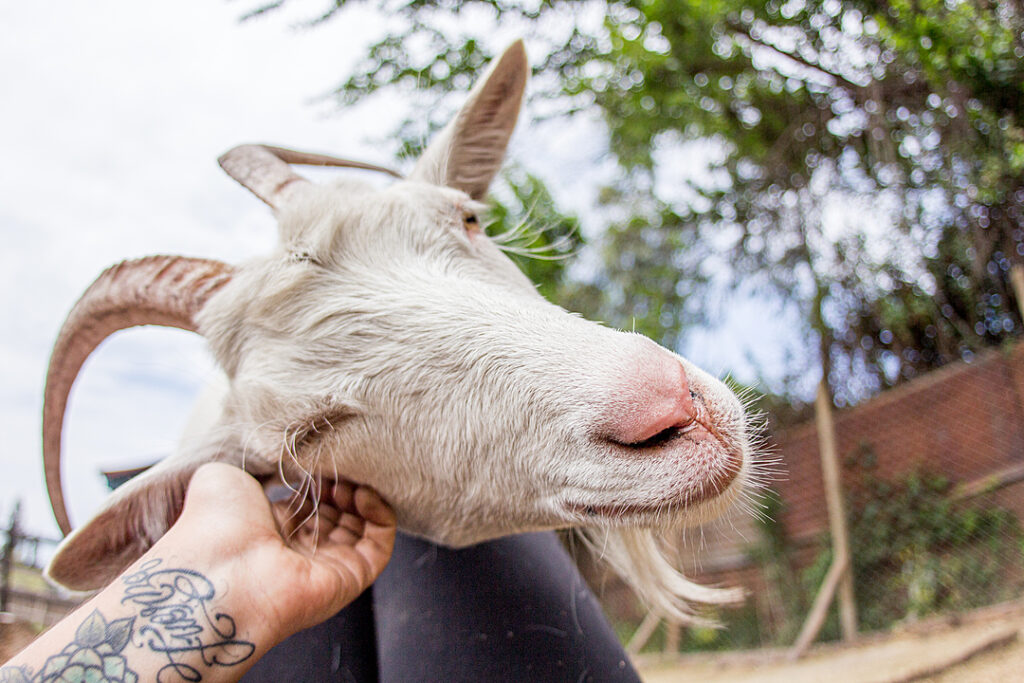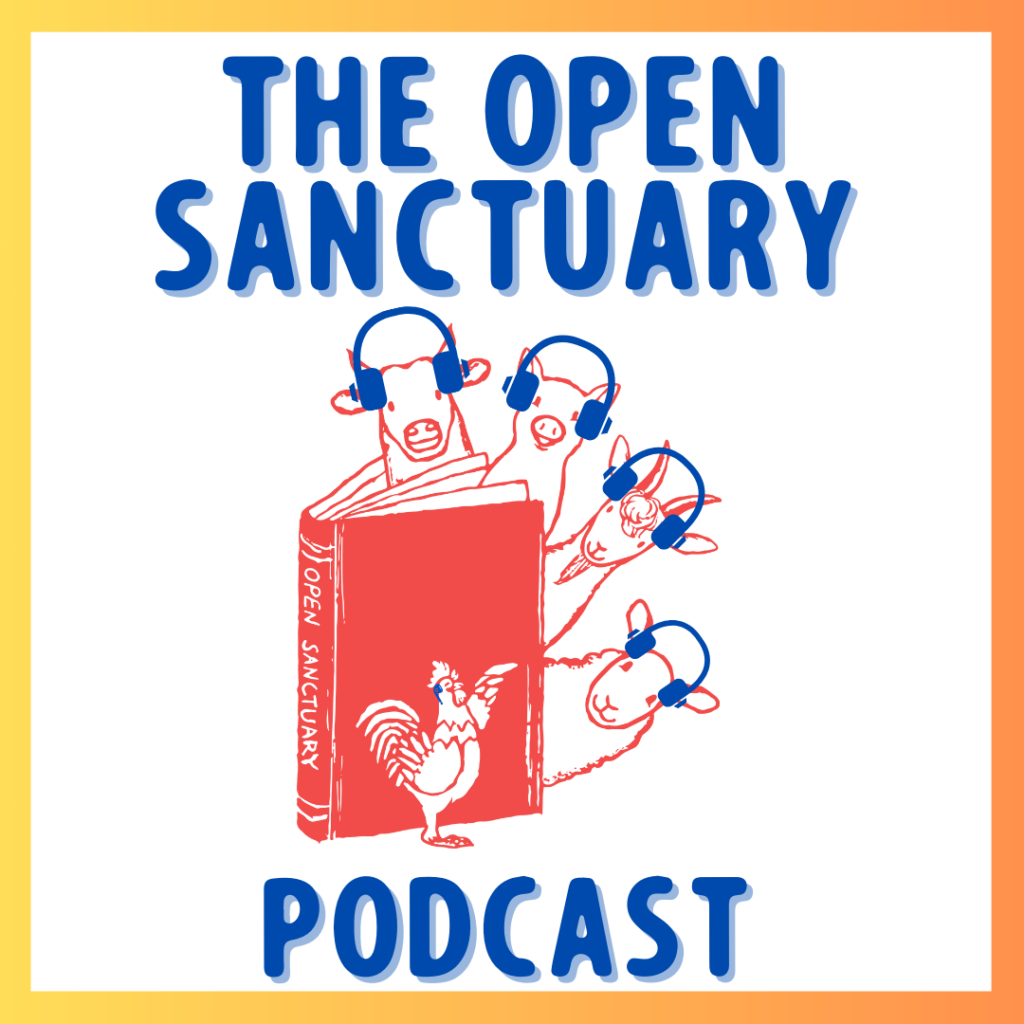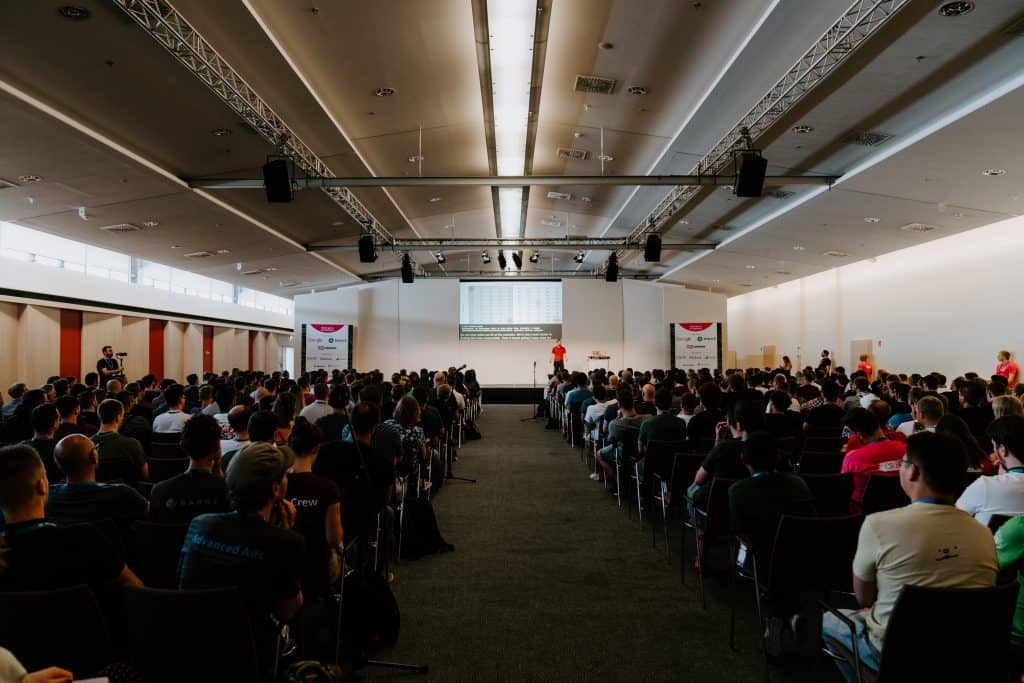

We Have A Podcast Episode On This Subject!
Want to learn about this topic in a different format? Check out our episode of The Open Sanctuary Podcast exploring some in-person sanctuary education options!
Introduction
Whether you’re just getting started or have been running an animal sanctuary for quite some time now, education often becomes an important part of your organization’s mission. Though many sanctuaries choose to facilitate onsite tour programs as part of their education strategy, there are a number of other ways to provide in-person educational opportunities for your community to connect with your sanctuary’s residents and mission that can be adapted to your specific philosophy, needs, and capabilities. The purpose of this resource is to provide animal sanctuaries with a general overview of several different possible in-person programs and educational offerings. Though all of them will not be relevant or feasible for every organization, each one offers unique learning opportunities and challenges that should be considered prior to planning and implementation.
Onsite Tours

Onsite tours can offer visitors a great opportunity to respectfully connect with sanctuary residents in a more natural learning environment. They also allow sanctuaries the opportunity to share their residents’ stories, raise awareness about the issues farmed animalsA species or specific breed of animal that is raised by humans for the use of their bodies or what comes from their bodies. face, provide in-person calls to action, and get good feedback from visitors. Appropriately facilitated onsite tours are a proven method of positively changing visitors’ attitudes about farmed animals and lessening their consumption of animal productsAnything that originates from an animal’s body, including things like their eggs, feathers, flesh, honey, milk, and wool..
In addition to all of the opportunities onsite tours can offer, there are some potential challenges and questions you’ll want to take into consideration:
- Safety: Animal sanctuaries are not petting zoos and it can be invasive to have strangers coming through the residents’ home on a regular basis. If you have onsite tours where visitors sometimes either directly or indirectly interact with the residents, your sanctuary will need to carefully consider what measures, protocols, and practices you will have in place to ensure the residents, staff, volunteers, and visitors are all comfortable and safe throughout your entire program. This should include both physical and emotional safety measures. You will also need to have a contingency plan in place in the event of an unforeseen emergency.
- Accessibility:
- Where is your sanctuary located? Are you centrally located or near a major city? Geographical distance and financial limitations can make it difficult for a lot of folks to get to sanctuaries.
- What kind of terrain is your sanctuary located on? Will your tours be adapted for people with different hearing, visual, and physical disabilities? Will there be seating arrangements for folks who can’t stand or walk for long periods of time? Walking tours can also be tough on children, pregnant people, and older adults.
- Will you have onsite restrooms for your visitors?
- Will you provide and/or sell food and beverage for your visitors?
- Tour guides and sanctuary educators:
- Who will facilitate your tours?
- What type of training will you provide your educators?
- Giving sanctuary tours can be an incredibly rewarding experience. It can also be very emotionally and physically draining. How will you support your sanctuary educators through this process?
In-classroom Visits

In-classroom visits are great opportunities for sanctuary educators to physically go into school settings and share their mission and extend their knowledge to students in a stimulating way. They can be tailored to meet the needs of individual classes or they can be designed as ready-to-teach programs that teachers and students choose from ahead of time.
Geographical accessibility, travel time, and travel costs are typically the biggest hurdles sanctuary educators will face if they decide to facilitate in-classroom visits. Educators will also need to have good classroom management skills. There are a lot of impactful exercises you can incorporate that are only possible in-person, such as role play. In-classroom visits can also offer hands-on learning experiences without the online distractions that can come with virtual learning programs.
Kids’ Camps

Facilitating a kids’ camp at your sanctuary can provide children and young adults fun experiential learning opportunities in a unique environment where they have the chance to interact with sanctuary residents, complete hands-on service-learning projects, and build friendships rooted in empathy and compassion. Camps vary in length, though most are a week-long and offer campers a chance to learn a lot.
Though they are a creative way to showcase your work and get more people to join your sanctuary community, designing a kids’ camp requires a lot of time and commitment – not only in planning, but in facilitating as well. It can also require a substantial financial investment depending on the added expenses it will take to operate a camp at your sanctuary. You’ll need to consider maintenance fees and materials costs and invest in quality camp facilities and facilitators that you can train and compensate fairly. You’ll also need to consider the health and safety of your residents, staff, volunteers, and campers (examples: camper medications, dietary needs, and allergy considerations) and have a contingency plan in case of an emergency.
Onsite Workshops

Onsite workshops are brief intensive educational programs you can design for a relatively small group of people that engage in discussion and activity on a particular subject or skill-share. A good workshop is usually organized by someone who can comfortably and enthusiastically facilitate a group of people without setting the entire agenda or injecting too many of their own ideas into the discussion. They should also include a good balance of different types of activities and breaks in a light-hearted and inspiring space. Workshops are great opportunities for participants to develop new relationships, meet new friends, and generate new ways of thinking as they share their experiences and learn together.
Though they are usually less tedious to plan than conferences, workshops require a lot of preparation. It’s important to know what your goals and roles are as a facilitator. You’ll want to plan and lead activities in a creative way that allows the group to do their best thinking together. Each participant should be given the chance to participate and contribute to discussions equally. You’ll also want to research and choose the right space and involve co-facilitators if necessary. Depending on the length of the workshop, you will likely want to consider providing food and beverages as well.
While workshops can be tailored toward adult groups, they can also be tailored toward groups of children as well, including school groups. If your sanctuary is interested in providing individual or ongoing workshops for kids, The Open Sanctuary Project has created eight free downloadable sanctuary education lesson plans that can be modified and adapted to suit your sanctuary and audience’s specific needs. Four of them are geared toward early elementary-aged learners and the other four are geared toward late elementary-aged learners. The lesson plans include topics such as empathy building, community gardening, and art as activism. To learn more about these lesson plans, please type in “lesson plan” in our website’s search bar and explore all the options! You can also click here to check out the first late elementary lesson plan and here to check out the second late elementary lesson plan. Even if you’re not interested in utilizing one of these specific plans, they might at least provide your sanctuary with some inspiration to develop your very own lesson plans!
Conferences

A conference is a formal gathering of people who share common goals and ideals. They typically focus on discussions and speeches covering specific topics over a long period of time. Participants are experienced and knowledgeable in the topics being discussed, though they do not necessarily have to be experts. Here are some reasons you might want to consider organizing and hosting a conference:
- Conferences are usually held in larger spaces. This gives you a chance to reach and meet a large group of people. As such, they offer great networking opportunities for attendees who want to strengthen their community and be with like-minded people.
- Conferences are a fun way to generate new ideas and approaches that can make your sanctuary work more effective.
- Conferences can also be a great place for you to establish thought leadership and fundraise.
Here are some of the challenges you might face if you decide to organize and host a conference:
- Though great for networking, conferences offer participants fewer chances to get hands-on experience.
- Because they are intended for larger audiences, conferences don’t always afford folks the ability to have all of their questions answered.
- Though they are incredibly rewarding, conferences can also be challenging to organize as they are expensive and very time-consuming. It is a huge responsibility to plan a conference both in physical and mental labor.
- The venue can be costly – it needs to be comfortable and accessible.
- Conferences are long – lasting anywhere from several hours to several days. You’ll want to provide food and beverages.
- You’ll want to choose speakers carefully and compensate them fairly for their talks. At the very least, you’ll want to pay for their travel, lodging, and food.
- You’ll also want to hire a technical team to handle lighting, audio, and visuals.
- You will likely need one or more co-facilitators and/or volunteers to help you.
- Some other questions to consider:
- Will you have a cancellation policy?
- Will you have decorations and banners as well as lanyards and/or badges for attendees?
- How will you market and advertise such a large event?
Film Screenings

Film screenings are a fantastic way of getting people together to raise awareness on a specific issue. Movies spark ideas and invite people into conversation. As such, they can be powerful educational tools and act as catalysts for change.
Unless you choose to have a film screening in a paid venue, they usually cost relatively little money to host and can even provide you with the opportunity to fundraise and build your community. However, you’ll want to carefully consider the kind of equipment you’ll need. High quality projection and audio is important, as is comfortable seating. You’ll want to make careful considerations for people with hearing, visual, and physical disabilities. Here are some other questions to consider:
- Will you provide food and beverages?
- How will you market and advertise your film screening?
- How many staff members and/or volunteers will you need to effectively host this event?
Films are copyright protected.
If you choose to host a public film screening, you will need to obtain a film screening permission license (sometimes called a public performance license) from the film’s producers in order to show the film outside of a theater or home. This law applies whether or not you charge an admission fee for guests. Charging admission or collecting donations is also prohibited without a written contractual arrangement with the film’s producers, but there is an educational exception: The film must be a legitimate copy (example: on Netflix), part of a formal course and/or curriculum, and shown by an instructor who is physically present.
Conclusion
Now that you’ve read more about in-person educational programming, here are some important questions for your sanctuary to consider to help you determine what type of program would be most suitable and sustainable for your organization and its community:
- What kind of in-person education program is your sanctuary in the best position to design and facilitate?
- What are your opportunities for in-person education that draw on your sanctuary’s strengths and interests?
- What financial, technological, spatial, and staffing resources are available to you?
- What in-person educational opportunities are currently being offered in your community or region that you might support and build on?
- What in-person educational opportunities are not being offered in your community that you could start facilitating?
Deciding what type of education program(s) to design and facilitate at your sanctuary is an exciting and challenging task. Hopefully, this resource can serve you as an initial walk-through of the various benefits and challenges to different in-person program possibilities. If your sanctuary is interested in offering any virtual education opportunities, please go here to learn more.
Educational Programs and Opportunities Well-Suited for MicrosanctuariesMicrosanctuaries are small scale communities of human and nonhuman (generally “unconventional or farmed”) animal companions, who live together in a chosen shared lifestyle and in commitment to ending the oppression of all beings. Microsanctuaries adhere to the notion that no nonhuman member of the community should “serve a purpose.” Microsanctuaries can exist in any context: rural, suburban, or urban. A microsanctuary can consist of as small a community as one animal and one human caregiver. For more information on microsanctuary please refer to the Microsanctuary Resource Center.
While the educational programs and opportunities described in this resource can be and have been applied in microsanctuaryA microsanctuary is a small scale community of human and nonhuman (generally “unconventional or farmed”) animal companions, who live together in a chosen shared lifestyle and in commitment to ending the oppression of all beings. Microsanctuaries adhere to the notion that no nonhuman member of the community should “serve a purpose.” Microsanctuaries can exist in any context: rural, suburban, or urban. A microsanctuary can consist of as small a community as one animal and one human caregiver. For more information on microsanctuary please refer to the Microsanctuary Resource Center. settings, the interactions that can happen with respect to microsanctuaries are often quite distinct from the interactions that can happen with respect to macrosanctuariesMacrosanctuaries are large-scale communities of nonhuman (generally “unconventional or farmed”) animal companions and multiple human caregivers who do not typically share the same living space. Due to land requirements and zoning restrictions pertaining to certain species and larger resident numbers, macrosanctuaries typically exist in more rural settings. Macrosanctuaries adhere to the notion that no nonhuman member of the community should “serve a purpose” and are committed to ending the oppression of all beings. The term "macrosanctuary" has its origins in the The Open Sanctuary Project's desire to distinguish the microsanctuary and macrosanctuary communities. Although they serve a similar purpose, microsanctuaries and macrosanctuaries are inherently different in various ways.. This is in large part due to how they are uniquely positioned with respect to things like geographical accessibility, funding, organizational structure, philosophy, and more. Fortunately, when it comes to designing and facilitating educational and outreachAn activity or campaign to share information with the public or a specific group. Typically used in reference to an organization’s efforts to share their mission. efforts for microsanctuaries specifically, there are a number of wonderful ways to provide opportunities for folks to connect with their resident(s) and missionThe stated goals and activities of an organization. An animal sanctuary’s mission is commonly focused on objectives such as animal rescue and public advocacy. that are well-suited for and can be adapted to their specific needs and capabilities. To read more about educational programs and opportunities well-suited for microsanctuaries, click here.
Sources
So, You Want to Start a Farmed Animal Sanctuary | The Open Sanctuary Project
Fundamentals of an Effective Animal Sanctuary Tour Program | The Open Sanctuary Project
Strategic Planning for Educational Programming at Your Animal Sanctuary | The Open Sanctuary Project
Animal Sanctuary Visitor Surveys: How to Capture the Data that Counts | The Open Sanctuary Project
The Differences Between and Animal Sanctuary and a Petting Zoo | The Open Sanctuary Project
Overview of Animal Sanctuary Staff Positions | The Open Sanctuary Project
The Open Sanctuary Project’s Volunteer Policy Handbook | The Open Sanctuary Project
What to Consider When Children Visit Your Animal Sanctuary | The Open Sanctuary Project
Fostering Empathy Towards Farmed Animals | The Open Sanctuary Project
Virtual Sanctuary Educational Programming: What Are Your Options? | The Open Sanctuary Project
Late Elementary-Age Sanctuary Education Lesson Plan #1 | The Open Sanctuary Project
Late Elementary-Age Sanctuary Education Lesson Plan #2 | The Open Sanctuary Project
ADA Compliance and Accessibility for Animal Sanctuaries | The Open Sanctuary Project
Large Event Considerations at Your Animal Sanctuary | The Open Sanctuary Project
How to Develop a Fundraising Plan for Your Animal Sanctuary | The Open Sanctuary Project
A Farm Sanctuary Tour’s Effects On Intentions And Diet Change | Faunalytics






